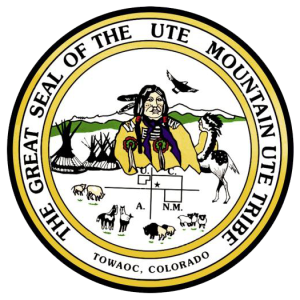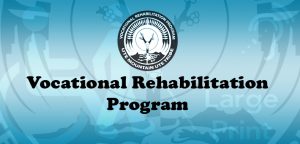Ute Mountain Ute VR Program Creates Traditionally Aligned Policies

In late March of 2024, AIVRTTAC staff traveled to the Ute Mountain Ute Vocational Rehabilitation (VR) Program to provide on-site intensive training and technical assistance (ITTA).
For Rebecca Holland (AIVRTTAC vocational rehabilitation coordinator and ITTA lead) and Paula Seanez (AIVRTTAC content expert and director of the Navajo Nation Office of Special Education and Rehabilitative Services), the drive from Durango to Towaoc, Colorado was amazing. Even through the snow you could see the incredible beauty of the area, with its pine forests and snowcapped peaks. About 15 miles from Towaoc – which means “Hello” in the Ute Mountain Ute language – the Ute Mountains became visible. This mountain range, about 12 miles long and isolated from other mountains, has a collective profile commonly known as “The Sleeping Ute.”

Legend has it that in the very old days, the Sleeping Ute Mountain was the Great Warrior God who came to help fight against the Evil Ones. A tremendous battle between the Great Warrior God and the Evil Ones followed. As they stepped hard upon the earth and braced themselves to fight, their feet pushed the land into mountains and valleys. This is how the landscape of the region came to be as it is today.
The Ute Mountain Ute Tribe are descendants of the Weenuche (Weeminuche, Weminuche, Weemeenooch, Wiminuc, Guiguinuches) and historically lived west of the Continental Divide along the Dolores River of western Colorado, in the Abajo Mountains. Six years after the Indian Reorganization Act of 1934, the Weenuche Band at Ute Mountain Ute Reservation organized a tribal government and enacted a tribal constitution. The Weenuche Band became the Ute Mountain Ute Tribe.
To say this place is sacred is an understatement. You can feel the unity and cohesion of those who live there. Despite their relative isolation and scarce resources, the people are proud of their land and community. It is clear that most would not wish to live anywhere else.

At the time of ITTA, the Ute Mountain Ute VR Program was directed by Carry Blackie. Having held her position for five months, Carry had worked diligently to restore the program and help the community understand the TVR process and the intent of the program. Carry utilized every resource she could find to increase her understanding of TVR and grant management. Carry has utilized every resource she could find to increase her understanding of TVR and grant management. She reached out to AIVRTTAC in January 2024 to request ITTA services, knowing that this would be an opportunity to receive one-on-one assistance with her program and job responsibilities.
The two-day staff training was focused on developing the program’s policies and procedures as well as discussing a culturally appropriate TVR program model. The training went by quickly and accomplished a great deal. It was beneficial for AIVRTTAC staff to be on-site and learn about this Native community (and the communities they serve) as well as have time to learn about the challenges and struggles the program faces.
Carry had the following to say about working with AIVRTTAC and receiving ITTA.
“Working alongside Rebecca Holland and Paula Seanez in developing the Ute Mountain Ute VR program policies and procedures was an incredibly valuable experience. Their guidance brought not only a wealth of information but also a sense of relief and advancement to our team. Their expertise allowed us to delve deeply into TVR information, enhancing our understanding and capability. Achieving our program objectives was undoubtedly a significant accomplishment, and their visit provided the much-needed boost that our program required. We are profoundly grateful for their assistance and the opportunity to work alongside such knowledgeable individuals.”
AIVRTTAC recognizes what an honor it is to visit native communities and facilitate site visits to TVR programs. We would like to thank Carry and her team for allowing us to be with them.
Interested in receiving ITTA or TTTA services from AIVRTTAC?
More Success Stories
Saint Regis Mohawk Tribe TVR Program Supports New Start-Up Business
Saint Regis Mohawk Tribe TVR Program Supports New Start-Up Business The Saint Regis Mohawk Tribe Vocational Rehabilitation (TVR) program helped me tremendously in pursuing and succeeding in my self-employment goals. The guidance they provided enabled me to not only gather my ideas into a business plan, but also connected me with experts in small business
Ute Mountain Ute VR Program Creates Traditionally Aligned Policies
Ute Mountain Ute VR Program Creates Traditionally Aligned Policies In late March of 2024, AIVRTTAC staff traveled to the Ute Mountain Ute Vocational Rehabilitation (VR) Program to provide on-site intensive training and technical assistance (ITTA). For Rebecca Holland (AIVRTTAC vocational rehabilitation coordinator and ITTA lead) and Paula Seanez (AIVRTTAC content expert and director of the Navajo
The SAGE Club – A Successful TVR Youth Readiness Initiative
The SAGE Club – A Successful TVR Youth Readiness Initiative This past year, the Cheyenne and Arapaho American Indian Vocational Rehabilitation Program (CAAIVR), in collaboration with the tribe’s 477 project, launched a groundbreaking youth work readiness initiative called DREAMS (Developing Responsible Employees Aptitude and Marketing Success). As part of this initiative, we developed the SAGE